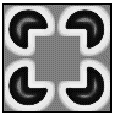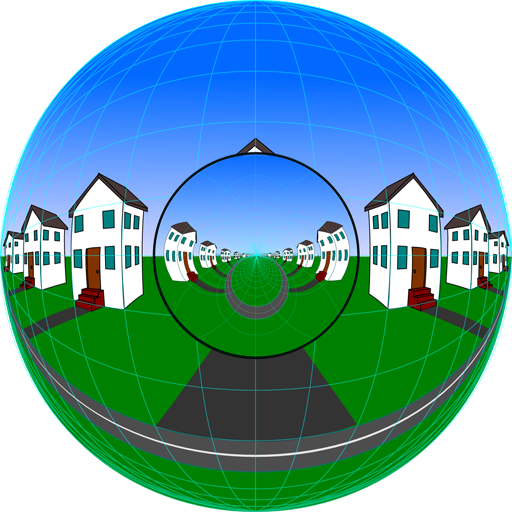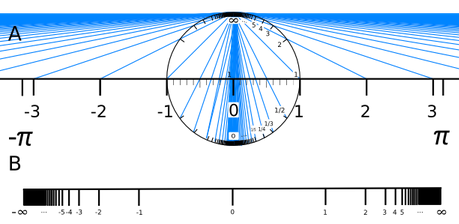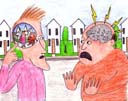
|
An informal cartoon presentation of the central
epistemological debate between naive realism and representationalism.
|
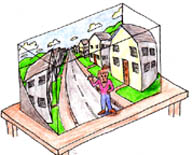
|
http://cns-alumni.bu.edu/~slehar/Tucson2006/Tucson2006Narrated.pps
A narrated PowerPoint presentation of a plenary talk given at the
Tucson 2006 consciousness conference showing that visual experience is
spatially structured, and thus, a model of visual experience must
also be expressed as a spatial structure. Theories of direct
perception, and projection theory are refuted.
|
My Books:
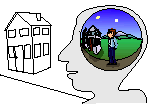
|
The World In Your Head: A Gestalt View of the
Mechanism of Conscious Experience
Publisher:
Lawrence Erlbaum Associates
This book presents a modern reformulation of Gestalt theory
based on the philosophy of indirect realism,
i.e. that the world you see around you is not the world
itself, but merely an internal replica of the external world
generated by perceptual processes in your brain. This reveals
the primary function of visual perception to be the generation
of a fully spatial virtual-reality internal model of the
external world.
|

|
This book explores the boundaries of human knowledge,
beginning with the root of all human knowledge which is our
conscious experience of the world.
[Download whole book
in PDF format]
|
My Principal Papers:
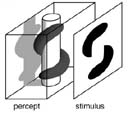
|
The Constructive
Aspect of Visual Perception: A Gestalt Field Theory Principle of Visual
Reification Suggests a Phase Conjugate Mirror Principle of Perceptual Computation
Many Gestalt illusions reveal a constructive, or generative
aspect of perceptual processing where the experience contains
more explicit spatial information than the visual stimulus on
which it is based. The experience of Gestalt illusions often
appears as volumetric spatial structures bounded by continuous
colored surfaces embedded in a volumetric space. These, and
many other phenomena, suggest a field theory principle of
visual representation and computation in the brain. A
two-dimensional reverse grassfire algorithm, and a
three-dimensional reverse shock scaffold algorithm are
presented as examples of parallel spatial algorithms that
address the inverse optics problem in perception. The
principle of nonlinear wave phenomena and phase conjugate
mirrors is invoked as a possible mechanism.
|

|
Gestalt Isomorphism
and the Primacy of the Subjective Conscious Experience:
A Gestalt Bubble Model. (2003) Behavioral & Brain
Sciences 26(4), 375-444.
[Download pdf file]
The world of visual consciousness appears in the form of solid
volumes, bounded by colored surfaces, embedded in a spatial
void. The retinal input on which it is based however is
two-dimensional. (in the monocular case) Visual processing
therefore computes a solution to the inverse-optics problem,
i.e. it performs a transformation from the two-dimensional
retinal input to the three-dimensional spatial percept. But the
inverse-optics problem is underconstrained, and has no unique
solution. I propose that perception resolves this fundamental
ambiguity by way of a unique kind of emergent field-like
computation as suggested by the Gestalt soap bubble analogy.
|
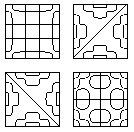
|
Harmonic Resonance Theory:
an Alternative to the "Neuron Doctrine" Paradigm of Neurocomputation
to Address Gestalt properties of perception
[Download pdf file]
The properties of the world of visual experience appear to
be inconsistent with contemporary concepts of
neurocomputation. For phenomenology presents the mind as a
three-dimensional colored structure, while neurophysiology
presents the brain as an assembly of discrete local
processors in a massively parallel network. Where in that
mass of neural circuitry are the three-dimensional
volumetric real-time moving pictures that we know so well in
conscious experience? A Harmonic Resonance theory is
presented as an alternative to the Neuron Doctrine,
to account for the holistic global aspects of perception
identified by Gestalt theory which are so difficult to
account for in conventional neural network terms.
|
|
|
Computational
Implications of Gestalt Theory I:
A Multi-Level Reciprocal Feedback (MLRF) to Model
Emergence and Reification in Visual Processing
[Download pdf file]
[Download pdf file]
This is a two-part paper that discusses the
computational implications of Gestalt theory. I propose a
perceptual modeling approach, i.e. to model the
subjective experience of vision rather than the
corresponding neurophysiological state. I propose specific
computational interactions to account for the Gestalt
properties of perception, and to explain the role of
feedback in vision with a specific computational model that
replicates a number of visual illusory phenomena. Part II
of the paper demonstrates
how the more subtle second order properties of
illusory contour formation can be modeled computationally
with a dynamic feedback model, as an alternative to the
hard-wired receptive field embodied in the neural network approach.
|

|
Directional Harmonic Theory:
A Computational Gestalt Model to Account for Illusory
Contour and Vertex Formation. (2003) Perception 32(4) 423-448.
[Download pdf file]
Neural network models have been proposed to account for the
formation of collinear illusory contours as seen for example
in the Kanizsa figure. There are however a number of illusory
grouping effects which involve perceived vertices defined by
the intersection of two, three, four, or more illusory
contours that meet at the vertex. A neural network approach to
this kind of perceptual grouping leads to a combinatorial
explosion in the number of required receptive fields. A
Directional Harmonic theory is presented to account for all of
these diverse grouping effects by way of a single simple
mechanism that involves harmonic resonances, or patterns of
standing waves in the neural substrate. A single resonance
mechanism replaces a whole array of different receptive fields
in a computationally equivalent neural network model. I
propose that harmonic resonance is the long-sought and elusive
computational principle behind the holistic emergent aspects
of Gestalt theory.
|

|
A short paper on the structure of conscious
experience and its implications for the nature of
consciousness.
|

|
[Download pdf file]
A short paper on the function of conscious experience
as an analogical representation of the external world.
|
My latest discovery is Clifford Algebra, a most extraordinary reformulation of all of mathematics that
reveals algebra to be actually a branch of geometry. It converts all algebraic relations into spatial relations
between spatial structures. It is simultaneously a geometrification of algebra and an algebrification of geometry.
David Hestenes (pron. "Hes-ten-es"),
who single-handedly rediscovered Clifford Algebra and brought it back to life from complete obscurity, then proceeded to improve on it with
two most extraordinary extensions, the projective geometry and the conformal geometry, concepts that are not exclusive
to Geometric Algebra, but are very simply expressed in it. These remarkable extensions reveal the intimate connection between
mathematics and perception, revealing mathematics to be an artifact of how our brain makes sense of spatial reality.
David Hestenes prefers the term "Geometric Algebra", which is the term proposed by Clifford himself, because "Clifford Algebra" sounds like
"just another algebra", whereas in fact Geometric Algebra is the radical discovery of the geometric roots of all of algebra.
The Perceptual Origins of Mathematics

A WordPress book on the origins of mathematics through the mechanism of perception.
Mathematics And Mind
Mathematics is not a human invention, mathematics is a discovery of a pre-existing system of laws and geometrical structures, and those laws and structures are themselves innate properties of the human mind, located in the human brain. We can reverse-engineer the computational principles of human perception and cognition by examining the laws of mathematics. This video demonstrates some of the remarkable properties of mathematics that reveal the operational principles of the mind and brain.
Mathematics And Mind
Including my PhD thesis, all of my journal submissions, and some
unpublished essays.
Some of My Creations:
Exerpts from Some of My Papers
Gallery of Miscellaneous Pictures
Quotes from various books:
General Quotes from various sources
More Quotes
Rudolf Arnheim (1969) Art and Visual Perception
Alfred Binet (1905)
Mind and Brain
J. J. Gibson
D. E. Harding (1960) On Having No Head.
Stephen Harrison (1986) The Mind/Brain Problem
Gaetano Kanizsa (1979) Organization in Vision
Immanuel Kant (1781) Critique of Pure Reason
Thomas Kuhn (1970) The Structure of Scientific Revolutions.
Wolfgang Köhler (various selections)
Jose Luis Marroquin (1976) Human Visual Perception of Structure.
Ramachandran & Blakeslee (1998) Phantoms in the Brain.
Bertrand Russell
Arthur Schopenhauer
Sir Charles Scott Sherrington
John Smythies (1994) The Walls of Plato's Cave.
Tom West(1997) In the Mind's Eye.
Edward O. Wilson (1998) Consilience.
References
Web Resources:
Web Search
Reference
ResearchIndex
My Favorite Links:
People:
.









